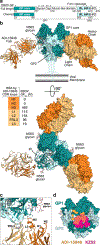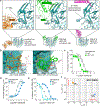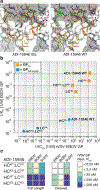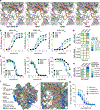Structural basis of broad ebolavirus neutralization by a human survivor antibody
- PMID: 30833785
- PMCID: PMC6402988
- DOI: 10.1038/s41594-019-0191-4
Structural basis of broad ebolavirus neutralization by a human survivor antibody
Abstract
The structural features that govern broad-spectrum activity of broadly neutralizing anti-ebolavirus antibodies (Abs) outside of the internal fusion loop epitope are currently unknown. Here we describe the structure of a broadly neutralizing human monoclonal Ab (mAb), ADI-15946, which was identified in a human survivor of the 2013-2016 outbreak. The crystal structure of ADI-15946 in complex with cleaved Ebola virus glycoprotein (EBOV GPCL) reveals that binding of the mAb structurally mimics the conserved interaction between the EBOV GP core and its glycan cap β17-β18 loop to inhibit infection. Both endosomal proteolysis of EBOV GP and binding of mAb FVM09 displace this loop, thereby increasing exposure of ADI-15946's conserved epitope and enhancing neutralization. Our work also mapped the paratope of ADI-15946, thereby explaining reduced activity against Sudan virus, which enabled rational, structure-guided engineering to enhance binding and neutralization of Sudan virus while retaining the parental activity against EBOV and Bundibugyo virus.
Figures






Similar articles
-
Structural Basis of Pan-Ebolavirus Neutralization by a Human Antibody against a Conserved, yet Cryptic Epitope.mBio. 2018 Sep 11;9(5):e01674-18. doi: 10.1128/mBio.01674-18. mBio. 2018. PMID: 30206174 Free PMC article.
-
Structural Basis of Pan-Ebolavirus Neutralization by an Antibody Targeting the Glycoprotein Fusion Loop.Cell Rep. 2018 Sep 4;24(10):2723-2732.e4. doi: 10.1016/j.celrep.2018.08.009. Cell Rep. 2018. PMID: 30184505 Free PMC article.
-
Proteo-Genomic Analysis Identifies Two Major Sites of Vulnerability on Ebolavirus Glycoprotein for Neutralizing Antibodies in Convalescent Human Plasma.Front Immunol. 2021 Jul 16;12:706757. doi: 10.3389/fimmu.2021.706757. eCollection 2021. Front Immunol. 2021. PMID: 34335620 Free PMC article.
-
Structural basis for differential neutralization of ebolaviruses.Viruses. 2012 Apr;4(4):447-70. doi: 10.3390/v4040447. Epub 2012 Apr 5. Viruses. 2012. PMID: 22590681 Free PMC article. Review.
-
Neutralizing ebolavirus: structural insights into the envelope glycoprotein and antibodies targeted against it.Curr Opin Struct Biol. 2009 Aug;19(4):408-17. doi: 10.1016/j.sbi.2009.05.004. Epub 2009 Jun 24. Curr Opin Struct Biol. 2009. PMID: 19559599 Free PMC article. Review.
Cited by
-
Convergence of a common solution for broad ebolavirus neutralization by glycan cap-directed human antibodies.Cell Rep. 2021 Apr 13;35(2):108984. doi: 10.1016/j.celrep.2021.108984. Cell Rep. 2021. PMID: 33852862 Free PMC article.
-
Structural Basis of Pan-Ebolavirus Neutralization by a Human Antibody against a Conserved, yet Cryptic Epitope.mBio. 2018 Sep 11;9(5):e01674-18. doi: 10.1128/mBio.01674-18. mBio. 2018. PMID: 30206174 Free PMC article.
-
Pan-ebolavirus serology study of healthcare workers in the Mbandaka Health Region, Democratic Republic of the Congo.PLoS Negl Trop Dis. 2022 Mar 7;16(3):e0010167. doi: 10.1371/journal.pntd.0010167. eCollection 2022 Mar. PLoS Negl Trop Dis. 2022. PMID: 35255093 Free PMC article.
-
Prominent Neutralizing Antibody Response Targeting the Ebolavirus Glycoprotein Subunit Interface Elicited by Immunization.J Virol. 2021 Mar 25;95(8):e01907-20. doi: 10.1128/JVI.01907-20. Epub 2021 Feb 3. J Virol. 2021. PMID: 33536172 Free PMC article.
-
Variant-proof vaccines - invest now for the next pandemic.Nature. 2021 Feb;590(7846):386-388. doi: 10.1038/d41586-021-00340-4. Nature. 2021. PMID: 33558746 No abstract available.
References
-
- Corti D et al. Protective monotherapy against lethal Ebola virus infection by a potently neutralizing antibody. Science 351, 1339–1342 (2016). - PubMed
-
- Cox E et al. Notes for the record: consultation on monitored emergency use of unregistered and investigational interventions for Ebola virus disease. World Health Organization; (2018). Available at: http://www.who.int/emergencies/ebola/MEURI-Ebola.pdf?ua=1 (Accessed: 17th August 2018)
-
- Sivapalasingam S et al. Safety, pharmacokinetics, and immunogenicity of a co-formulated cocktail of three human monoclonal antibodies targeting Ebola virus glycoprotein in healthy adults: a randomised, first-in-human phase 1 study. Lancet Infect. Dis. 18, 884–893 (2018). - PubMed
Methods-only references:
-
- McPhillips TM et al. Blu-Ice and the distributed control system: software for data acquisition and instrument control at macromolecular crystallography beamlines. J. Synchrotron Radiat. 9, 401–406 (2002). - PubMed
Publication types
MeSH terms
Substances
Grants and funding
LinkOut - more resources
Full Text Sources
Other Literature Sources
Medical
Molecular Biology Databases
Miscellaneous

